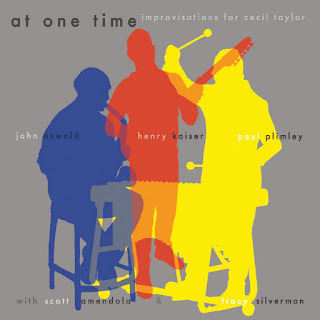By Paul Acquaro
I was tipped off to John Oswald, Henry Kaiser and Paul Plimley’s At One Time at the same time that I learned that Canadian pianist Paul Plimley, who plays vibraphone on this recording, had just passed away rather suddenly from cancer. Wanting to know more about Plimley, his work and life, I turned to my Free Jazz Blog colleague Stuart Broomer, whose knowledge of experimental music in Canada is vast, for help. Please see his wonderful tribute to Plimley here.
As for At One Time, let us start with Plimely, whose playing is simply excellent. His vibraphone playing outlines melodic and rhythmic ideas with incisive directness and he is in good company with guitarist Henry Kaiser and saxophonist John Oswald, along with guests, drummer Scott Amendola and 6-string fiddler Tracy Silverman. Perhaps though the most important member of the group is the one who is not there at all, but who both shapes and structures the entire recording, Cecil Taylor. Each member of the trio had played with Taylor at one point, and the influential and dynamic pianist is the recording’s binding presence.
Using some extended down time during the pandemic, the group members each separately improvised to a series of Taylor’s recordings that they then combined to create the new tracks of this recording. This novel approach to creating spontaneous music from a distance, and not all at once, could have failed as such music would seem to require hearing and feeling the subtleties of each other’s playing and presence, however it succeeds wonderfully as the process completely disappears into the music.
The opening track, ‘Anagram Ritz Rewording,’ starts with a quick blast from Oswald and stark, percussive strikes from Plimley. Kaiser can be heard on acoustic guitar, sticking to the lower register (it sounds like it is tuned low) and switching between chord fragments and walking bass-like single note lines. The music has a lightness, the three contributions are like fine intertwining lines, sometimes densely bunched and other times airy and flowing. The following track, ‘Oceans Felons Salad,’ sees Kaiser switching to electric guitar with a razor-edged tone. It also features the string playing of Tracy Silverman, a progressive minded player who combines electronics and effects with his unique 6-string fiddle, who adds a great deal of color to the track. The playing on this 27-minute track is more aggressive, Kaiser’s lines slice through and Oswald can be heard in short intense bursts. Plimley’s vibes hover throughout the background, sometimes coming into the foreground, but often providing a gentler sound to contrast with Kaiser and Silverman. ‘Targeted for Who,’ track three, is a quick duo between Oswald and Kaiser. The electric guitar supports Oswald’s atonal melody with suspended chords. Next, ‘Loon,’ is a duo between Kaiser and Plimley. On it, Kaiser returns to acoustic guitar and his Derek Bailey-like approach to the instrument here is a real highlight as Plimley darts around the impressionistic plucking with dexterous precision. The closing track, ‘Fir Loom,’ features Scott Amendola on drums. The percussion adds an extra bit of pulse to the music and again the pieces, all recorded separately, fit together flawlessly.
At One Time is a remarkable recording, utilizing an unusual concept for recording that results in a real time collaboration made in separate times and spaces. It is a result of chance – how easily could the distant collaborations not have meshed so well? – as well as a document of deeply intuitive musicians whose own reactions to Taylor’s music are captivating in their own right. I believe that At One Time came out late enough in 2021 to technically fall into my top 10 for 2022.


